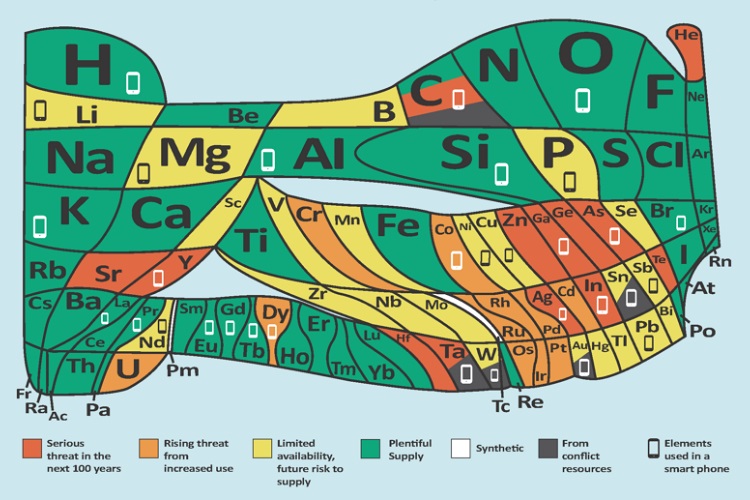The carbon element – the good, the bad and the ugly
The European Chemistry Society’s Element Scarcity Periodic Table has been updated to reflect the significance of carbon in the week world leaders meet in Glasgow to tackle climate change.
The table, which organises all discovered chemical elements allowing scientists to quickly refer to an element’s properties such as its atomic mass and chemical symbol, is a key resource and classroom staple.
Today (Wednesday 3 November 2021), to coincide with COP26, the European Chemical Society (EuChemS) has released this updated version of its iconic Periodic Table, first produced for the International Year of the Periodic Table in 2019.

For the first time, that version highlighted element availability and vulnerability and was created by a task group chaired by former President of the Society, University of St Andrews Professor of Chemistry, David Cole-Hamilton.
The new updated version released today (Wednesday 3 November 2021) graphically highlights the problems of carbon in our world now. Usually green, carbon features in the new table as a tricolour of green, red and grey which each represent a separate attribute of carbon.
The green represents the plentifulness of carbon in the form of carbon dioxide, carbonate rocks and vegetation; red represents that this plentifulness will cause serious problems if nothing is done to restrict its use; and grey reflects the fact that carbon resources, especially oil, can emanate from conflict resources such as from countries at war over oilfields or where oil revenues are used to fight wars.
Professor David Cole-Hamilton said: “This updated version of the Periodic Table graphically highlights the problems of carbon in our world now.
“If we behave responsibly by cutting our dependence on fossil fuels and never using them from conflict resources, we can save our beautiful and diverse planet and restore carbon to its rightful green colour.”
The carbon cycle balances photosynthesis, by which plants grow taking up carbon dioxide (CO2), with respiration (breathing) by which humans and all flora and fauna live and give out CO2.
For millennia these two processes, compounded by CO2 absorption and release by the oceans, have been in balance, justifying the benign green colour given to carbon in the 2019 Periodic Table.
Burning carbon-based fuels (coal, oil, gas) pumps so much extra CO2 into the air that photosynthesis and the oceans can’t keep up, causing CO2 levels to rise leading to global warming and climate change that will cause severe disruption to all forms of life on the planet in very much fewer than 100 years if we do nothing, hence the red colour.
The grey colour arises because, although most coal, oil and gas extraction is untainted by conflict, the proceeds of some oil sales are used to fund wars.
EuChemS President, Professor Floris Rutjes, said: “With the release of the updated version of the EuChemS Periodic Table, the European Chemical Society aims to keep drawing attention to the scarcity of elements, which is a global problem that affects all of us.
“In particular the change in the colour of carbon shows the increasing challenges that we are facing with greenhouse gas production, which are far from being solved.”
Professor Nicola Armaroli, Chair of the EuChemS Task Group on the Periodic Table and Executive Board member, said: “Plentiful carbon is the key chemical ingredient of life on Earth, but our energy-thirsty civilisation has made it an intricate environmental and geopolitical problem.
“The updated version of the EuChemS Periodic Table depicts the complexity of a unique element that will define the way we live up to the sustainability challenge being addressed at COP26 in Glasgow.”
The updated version of the Periodic Table can be downloaded from EuChemS website.
Issued by the University of St Andrews Communications Office.